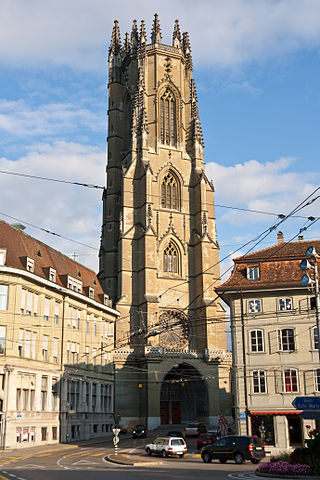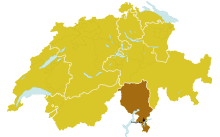A titular see in various churches is an episcopal see of a former diocese that no longer functions, sometimes called a "dead diocese". The ordinary or hierarch of such a see may be styled a "titular metropolitan", "titular archbishop" or "titular bishop", which normally goes by the status conferred on the titular see.

The Archdiocese of Manila is the archdiocese of the Latin Church of the Catholic Church in Metro Manila, Philippines, encompassing the cities of Manila, Makati, San Juan, Mandaluyong, Pasay, and Taguig. Its cathedral is the Minor Basilica and Metropolitan Cathedral of the Immaculate Conception, also known as the Manila Cathedral, located in Intramuros, which comprises the old city of Manila. The Blessed Virgin Mary, under the title Immaculate Conception, is the principal patroness of the archdiocese.

The Diocese of Magdeburg is a Latin Church diocese of the Catholic Church, located in the German state of Saxony-Anhalt. Its seat is Magdeburg; it is suffragan to the Archdiocese of Paderborn.

The Archeparchy of Changanacherry is a Syro-Malabar Catholic archeparchy with an area of 24,595 km2 comprising the districts of Kottayam, Alappuzha, Pathanamthitta, Kollam, and Thiruvananthapuram in Kerala, and also Kanyakumari district in Tamil Nadu. It is one of the largest Catholic dioceses in India in terms of area. Joseph Perumthottam is the current Metropolitan Archbishop, serving since 2007. Thomas Tharayil has been the auxiliary bishop since 2017. Suffragan eparchies of the Changanassery archeparchy includes Palai, Kanjirappally-Nilackal, and Thuckalay-Thiruvithancode.

The Diocese of Trebinje-Mrkan is a particular church of the Catholic Church in Bosnia and Herzegovina. Established in the 10th century, is the oldest Catholic diocese in Bosnia and Herzegovina. By the number of faithful, it is also the smallest. Its seat is in Trebinje.

The Metropolitan Archdiocese of Vrhbosna is an ecclesiastical archdiocese of the Catholic Church. Its territorial remit includes the eastern parts of Bosnia and Herzegovina and the entirety of the Republic of North Macedonia. Its episcopal see is the city of Sarajevo (Vrhbosna), the capital of Bosnia and Herzegovina. The archdiocese has the following suffragans: in North Macedonia the Diocese of Skopje; in Bosnia, the dioceses of Banja Luka, Mostar-Duvno and Trebinje-Mrkan.

The Diocese of Sion is a Latin Catholic ecclesiastical territory in the canton of Valais, Switzerland. It is the oldest bishopric in the country and one of the oldest north of the Alps. The history of the Bishops of Sion, of the Abbey of St. Maurice of Valais as a whole are inextricably intertwined.

The Archdiocese of Wrocław is a Latin Church ecclesiastical territory or archdiocese of the Catholic Church centered in the city of Wrocław in Poland. From its founding as a bishopric in 1000 until 1821, it was under the Archbishopric of Gniezno in Greater Poland. From 1821 to 1930 it was subjected directly to the Apostolic See. Between 1821 and 1972 it was officially known as (Arch)Diocese of Breslau.

The Diocese of Lausanne, Geneva and Fribourg is a Latin Catholic diocese in Switzerland, which is exempt. The original diocese of Lausanne was a suffragan of the archdiocese of Besançon, through the 18th century. The diocese of Geneva was a suffragan of the archdiocese of Vienne.

The Archdiocese of Berlin is a Latin Church ecclesiastical territory or archdiocese of the Catholic Church in Germany. The archepiscopal see is in Berlin, with the archdiocese's territory extending over Northeast Germany.

The Diocese of Galway, Kilmacduagh and Kilfenora is a Latin Church diocese of the Catholic Church in the west of Ireland. It is in the ecclesiastical province of Tuam and is subject to the Metropolitan Archdiocese of Tuam. The deanery of Kilfenora, previously a diocese in its own right, lies in the ecclesiastical province of Cashel. The ordinary is Bishop Michael Duignan who was appointed on 11 February 2022.

The Diocese of Wilcannia–Forbes is a Latin Church ecclesiastical jurisdiction or diocese of the Catholic Church in Australia. It is a suffragan in the ecclesiastical province of the metropolitan Archdiocese of Sydney. The Diocese of Wilcannia–Forbes was established in 1887, initially as the Diocese of Wilcannia. The diocese adopted its current name in 1917 when six parochial districts of Diocese of Bathurst, including those of Parkes and Forbes, were added to its western neighbour. The diocese covers the Far West region of New South Wales in Australia. The Bishop's office is in Forbes but his seat is in Sacred Heart Cathedral, Broken Hill.

Martin Marty was a Swiss-born Benedictine missionary and Catholic bishop in the United States.

The Diocese of Görlitz is a Latin Church diocese of the Catholic church in Germany. The current ordinary is Wolfgang Ipolt

Gaspard Mermillod was a Swiss Cardinal of the Roman Catholic Church. Despite a lengthy investiture conflict with the Calvinist Canton of Geneva, he served as Bishop of Lausanne and Geneva from 1883 to 1891, having previously served as Titular Bishop of Hebron. He was made a cardinal in 1890.

The Swiss Bishops' Conference is the coordinating body of the Catholic dioceses in Switzerland. It was founded in 1863 as the world's first Bishops Conference and is a member of the Council of European Bishops' Conferences.

The diocese of Eupen-Malmedy is a former Belgian Latin Roman Catholic diocese, which existed between 1919 and 1925, and included the East Cantons.
Aurelio Bacciarini was a Swiss Roman Catholic who served as the interim administrator of the Diocese of Lugano. He was a professed member of the Servants of Charity - also known as the Guanellians - and was also the founder of the Secular Institute of the Company of Saint Therese of the Child Jesus. He became known in his diocese as the "Apostle of the Sacred Heart".

The Chaldean Catholic Eparchy of Aleppo is the only eparchy of the Chaldean Catholic Church in Syria.

Ex hac augusta Principis Apostolorum cathedra is a papal bull issued by Pope Leo XIII on 5 July 1881, by which he restored the regular Church hierarchy in Bosnia and Herzegovina after its occupation by Austria-Hungary from the Ottoman Empire, with Archdiocese of Vrhbosna seated in Sarajevo having three suffragan dioceses: Banja Luka, Mostar-Duvno and Trebinje-Mrkan, with latter being under the administration of the bishop of Dubrovnik.




















